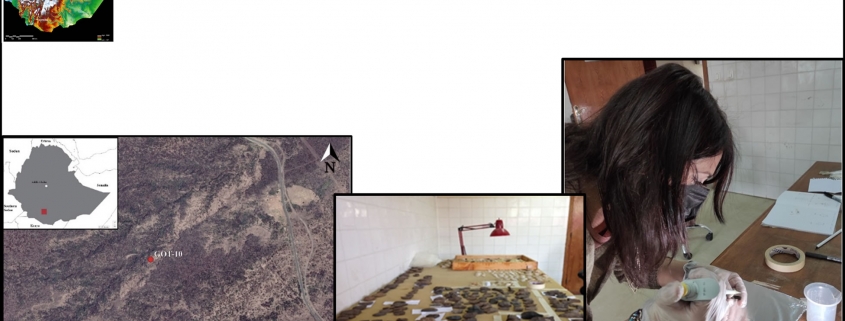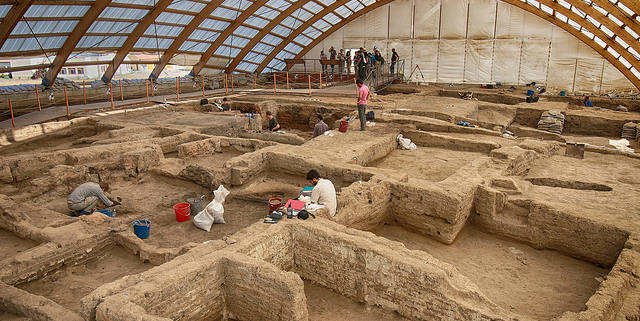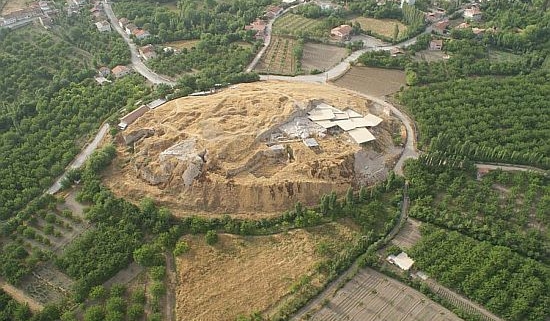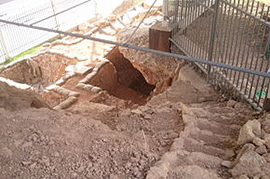Sites excavation director: E.E. Spinapolice, Department of Classics, Sapienza University of Rome
LTFAPA project: use-wear and residues analyses of chipped stone tools of the Area of Gotera
The area of Gotera, southern Ethiopia, is characterized by strong evidence of human occupation referred to the African Middle Stone Age (MSA).
It was discovered by Jean Chavaillon in the late 70’s, and since 2016 University of Rome La Sapienza is carrying out newly excavation and survey activities in the area. The aim of this research is the reconstruction of settlement dynamics and exploitation strategies of human groups during the Late Pleistocene in an area poorly analysed.
During four field seasons conducted in 2018, a high concentration of archaeological materials (both lithics and fauna) has been found and recorded in surface in an area of 2km2 and the discovery of the GOT-10 site in 2018 provided an archaeological sequence in a primary depositional context, yielding faunal remains, lithic implements, and structured fireplaces.
Systematic studies have been conducted and are still ongoing. The results will allow to improve our knowledge concerning the adaptation / evolution of the first representatives of our species in this area. Furthermore, is an important reference point to better understand population structures in East Africa during a period characterised by strong climatic oscillation.
LTFAPA lab is part of the team, and it is in charge of residue analysis and use wear analysis on the lithic assemblage from the stratigraphic context of GOT10.
Neolithic levels, Turkey
Site excavation director 1993-2018: prof. I.Hodder, Stanford University
Chipped stone tools use-wear analysis
Çatalhöyük is a well-known site located in Central Anatolia that was occupied for 2,000 years; the Neolithic East Mound dates from 7400 BCE to 6000 BCE and the Chalcolithic West Mound covers the first half of the 6th millennium BCE. The Pottery Neolithic village extends over many hectares suggesting a dense population in ancient times. The Neolithic village is especially known for the evidences of rituals and symbolism expressed by burials, wall paintings and mural art. Çatalhöyük is a key site for understanding the social and economic change that characterized the first farming communities of the Near East. A huge team of specialists, directed by J.Hodder, is working from many years to analyze the stratigraphy, the ecofacts and artifacts that form the site.
From 2013 the LTFPA is part of the Çatalhöyük research team with a research project aimed at understanding the social and economic role of chipped stone tools found in the Neolithic village using a use-wear approach. In particular, the project is focused on the study of the activities carried out inside and outside the buildings as a means for clarifying the role of different type of spaces in the social life of the village with a chronological perspective.
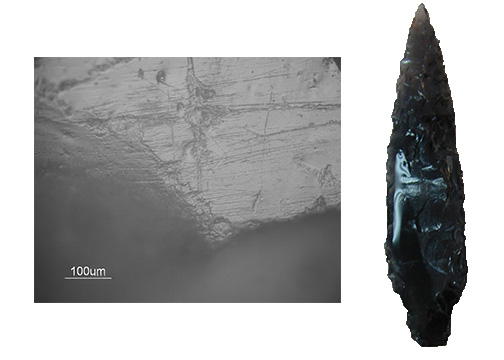
The chipped stone tools coming from the internal and external areas pertaining to various buildings from the North and South Areas of East Mound were studied or are under study. Generally, these lithic tools were used for a great variety of activities related to the processing of plants, animal, and mineral materials. Crafts activities related to the production of small stone objects, as beads or similar, are often present both inside and outside the buildings. The study of “special buildings” characterized by elaborated installations, as building 77, showed a lack of activities carried out in its spaces with lithic tools that confirms a different use than the domestic one ascribed toother buildings.
Related bibliography
Archive Reports 2013, 2014, 2015, 2017; http://www.catalhoyuk.com/archive_reports/
Lemorini C, D’Errico D., De Angelis A. Highlighting specialization in prehistoric societies with a use-wear approach Çatalhöyük, Central Anatolia (neolithic phases) and Arslantepe, East Anatolia (EbA phase) in comparison In R.Peake, S.Bauvais, C.Hamon, C.Mordant (eds.) Specialised productions and specialists, Proceedings of the session n° XXXIV-2 of the XVIII° UISPP World Congress, Société préhistorique française, 2020 (Séances de la Société préhistorique française, XXXIV-2), ISSN : 2263-3847 – ISBN : 2-913745-83-0DECEMBER 27, 2020
Torre della Chiesaccia, Casetta Mistici (Copper Age, Latium Italy)
References
Lemorini C. Caricola I., Nunziante Cesaro S. 2020 4.4. – Le punte foliate dai contesti funerari di Torre della Chiesaccia (Roma): analisi delle tracce d’uso e dei residui d’uso In G.Carboni, A. Anzidei (eds. ) Roma prima del mito. Abitati e necropoli dal Neolitico alla prima metà dei metalli nel territorio di Roma (VI-III millennio a.C.), pp. 437-444. Archeopress, Oxford. ISBN 978-1-78969-308-9
Caricola I, Lemorini C. 2020 4.6 – I pugnali litici da Torre della Chiesaccia e Casetta Mistici (Roma): analisi preliminare delle tracce d’uso In G.Carboni, A. Anzidei (eds. ) Roma prima del mito. Abitati e necropoli dal Neolitico alla prima metà dei metalli nel territorio di Roma (VI-III millennio a.C.), pp. 449-453. Archeopress, Oxford. ISBN 978-1-78969-308-9
Celant A. Lemorini C., Nunziante Cesaro S. 2020 4.5 – Analisi delle tracce d’uso e dei residui organici di una punta foliata dal corredo della tomba 8 di Casetta Mistici In G.Carboni, A. Anzidei (eds. ) Roma prima del mito. Abitati e necropoli dal Neolitico alla prima metà dei metalli nel territorio di Roma (VI-III millennio a.C.), pp. 445-448. Archeopress, Oxford. ISBN 978-1-78969-308-9
Metal Age metal industries recently studied at LTFAPA
References
Petitti P., Rossi F., Lemorini C., Pellegrini A. 2020 Le punte di lancia del lago di Mezzano (Valentano, VT): uno sguardo d’insieme Atti del XIV PPE 7-8-9 settembre 2018 Valentano, Pitigliano, Marciano.
Chalcolithic-Bronze Age, Turkey
Site excavation director: prof. F.Balossi-Restelli, Sapienza University of Rome
Chipped stone tools and macro-lithic tools use-wear and residues analyses
Moreover, LTFAPA is dealing also with the technological and functional study with traces analysis of the macro-lithic tools of the Arslantepe sequence, from Late Chalcolithic to Hittites Age. A PhD project (A.De Angelis PhD candidate Sapienza) is now focused on the macro-lithic tools of the village EBA VIB2 and their role in this community in both the domestic and the public spheres.
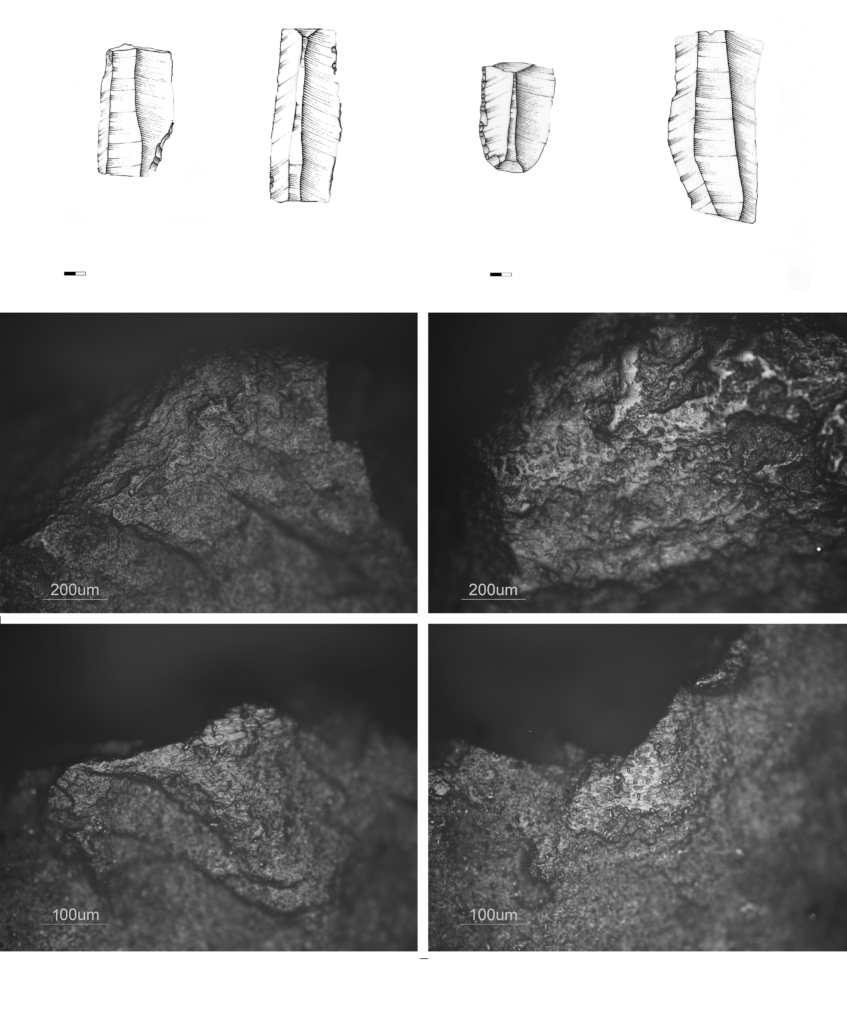
Another line of research was opened with three dissertations, respectively BA and MA dissertations on the production techniques of the stone beads from the Late Chalcolithic and Early Bronze Age levels of Arslantepe and a MA dissertation regarding the interpretation of the weaving techniques at Late Chalcolitic 5 VIA using an integrated approach of experimental archeology and traces analysis applied to the seals impressions on clay, “cretulae”, found in the storage areas of the administrative building. The weaving techniques were also investigated through the analysis of the spindle-whorls made of pottery and of bone found in various phases of the sequence of Arslantepe.
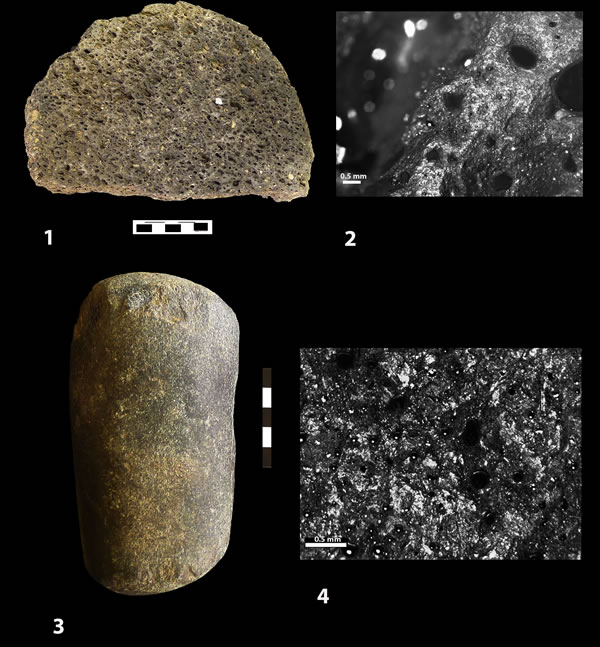
References
Laurito R., Lemorini C., Perilli A. (2014), Cap. 10, Making Textiles at Arslantepe, Turkey, in the 4th and 3rd Millennia BC. Archaeological Data and Experimental Archaeology. In: C.Breniquet, C.Michel (eds.), Wool economy in the ancient Near East and the Aegean. From the beginnings of sheep husbandry to institutional textile industry, Ancient Textile Series, vol. 17, Oxbow Books, Oxford, pp. 151-168.
Piccione, P.; Alvaro, C.; Bartosiewicz, L.; Lemorini, C.; Masi, A.; Sadori, L. 2015. Distribution of artifacts and ecofacts in an Early Bronze Age house in Eastern Anatolia: Space use and household economy at Arslantepe VI B2 (2900–2750 BCE). In Journal of Archeological Sciences Reports vol 4, pp. 8-22. http//doi:10.1016/j.jasrep.2015.08.035.
Balossi Restelli, F., Conati Barbaro C., Lemorini C., Mori, L., D’Errico D. 2017 Bread in Prehistory. Looking for the path of an extraordinary invention. In Manetti C. , Rufo F. (a cura di) Berad. An Interdisciplinary Perspective. Collana Sudi e Ricerche 57, Università di Roma Sapienza.
Lemorini C, D’Errico D., De Angelis A. Highlighting specialization in prehistoric societies with a use-wear approach Çatalhöyük, Central Anatolia (neolithic phases) and Arslantepe, East Anatolia (EbA phase) in comparison In R.Peake, S.Bauvais, C.Hamon, C.Mordant (eds.) Specialised productions and specialists, Proceedings of the session n° XXXIV-2 of the XVIII° UISPP World Congress, Société préhistorique française, 2020 (Séances de la Société préhistorique française, XXXIV-2), ISSN : 2263-3847 – ISBN : 2-913745-83-0
La Polledrara di Cecanibbio (Lower Paleolitich site, Italy)
Chipped stone tools use-wear analysis
References
Santucci E., Marano F., Cerilli E., Fiore I., Lemorini C., Palombo M.R., Anzidei A.P., Bulgarelli G.M., (2016), Palaeoloxodon exploitation in the late Middle Pleistocene site of Polledrara di Cecanibbio (Rome, Italy), Quaternary International 406, pp. 169-182, doi:10.1016/j.quaint.2015.08.042.
Lemorini, C.; Santucci, E.; Caricola, I.; Nucara, A.; Nunziante-Cesaro, S.. (2022) Life Around the Elephant in Space and Time: an Integrated Approach to Study the Human-Elephant Interactions at the Late Lower Paleolithic Site of La Polledrara di Cecanibbio (Rome, Italy), JOURNAL OF ARCHAEOLOGICAL METHOD AND THEORY. – ISSN 1072-5369. – (2022). [10.1007/s10816-022-09584-4]
Valle Giumentina (Lower and Middel Paleolitich site, Italy)
Chipped stone tools use-wear analysis
References
E. Nicoud, D. Aureli, M. Pagli, S. Agostini, G. Boschian, C. Chaussé, U. Colalelli, J.-P.Degeai, F. Fusco, M. Hernandez, C. Kuzucuoglu, C. Lahaye, C. Lemorini, P. Mazza, N. Mercier, V. Robert, M.-A. Rossi, V. Villa, C. Virmoux, A. Zupancich, 2014 Valle Giumentina (Abruzzes, Italie). Deuxième mission : étude des comportements techno-économiques au Pléistocène moyen, dansChronique des activités archéologiques de l’École française de Rome, 2014, [En ligne] URL : http://cefr.revues.org/1081
Nicoud E., Aureli D., Pagli M., Villa V., Chaussé C., Agostini S., Bahain J.-J., Boschian G., Degeai J.-Ph., Fusco F., Giaccio B., Hernandez M., Kuzucuoglu C., Lahaye, C. Lemorini C., Limondin-Lozouet N., Mazza P., Mercier N., Nomade S., Pereira A., Robert V., et al. (2015), Preliminary data from Valle Giumentina Pleistocene site (Abruzzo, Central Italy): A new approach to a Clactonian and Acheulian sequence, Quaternary International 406, pp. 182-194 doi:10.1016/j.quaint.2015.08.080
La Ficoncella (Lower Paleolitich site, Italy)
Chipped stone tools use-wear analysis
References
Aureli A., Contardi A., Giaccio B., Jicha B., Lemorini C., Madonna S., Magri D., Marano F., Milli S., Modesti V.,Palombo M.R,Rocca R. 2015 Palaeoloxodon and Human Interaction: Depositional Setting, Chronology and Archaeology at the Middle Pleistocene Ficoncella Site (Tarquinia, Italy). PLOSone, https://doi.org/10.1371/journal.pone.0124498
Aureli D., Rocca R., Lemorini C., Modesti V., Scaramucci S., Milli S., Giaccio B., Marano F., M.R. Palombo, Contardi A., (2016), Mode 1 or mode 2? “Small tools” in the technical variability of the European Lower Palaeolithic: The site of Ficoncella (Tarquinia, Lazio, central Italy), Quaternary International 393, pp. 169-184, https://doi.org/10.1016/j.quaint.2015.07.055.
Fontana Ranuccio (Lower Paleolithic site, Italy)
Chipped stone tools use-wear analysis
References
Marinelli F., Lemorini C., Zampetti D. 2019 La funzione degli “small tools” nell’ambito delle industrie litiche scheggiate Acheuleane della penisola italiana: il caso studio del sito laziale di Fontana Ranuccio (FR), Ipotesi di Preistoria 11, pp. 57-72. https://doi.org/10.6092/ISSN.1974-7985/9896
Qesem Cave (AYCC), Revadim, Jaljulia (Acheulean)
Site excavation director: A.Gopher, R.Barkai, Department of Archaeology, Tel Aviv University TAU
LTFAPA project Chipped stone tools use-wear and residues analysis funded by MAECI and by International Agreement Project of Speinza University
Qesem Cave and the open sites of Revadim and Jajiulia are located near Tel Aviv. Revadim and Jajiulia are two Late Acheulean sites reach in flint industry characterized by bifaces and by flakes, small flakes, tools, and small tools. At Revadim, the taphonomic processes allowed to preserve numerous remains of fauna that comprise mammals of different sizes and megafuana. Both sites are really promising for the analysis of use-wear and residues. As far as Revadim concerns, various publication documented the use of the lithic industry to carry out different types of activities among which butchering seems to prevail.
The intriguing question under study is if the items of small size, that are abundant at Revadim, may have been involved in the processing of megafauna. To explore the relationship small tools-megafauna a PhD project by TAU with the collaboration with LTFAPA Sapienza (PhD candidate F.Marinelli) is in progress and is starting to produce interesting results now under in publication. Qesem Cave is an extraordinary well-preserved site, consisting of sediments some 10m deep, all assigned to the Acheulo Yabrudian Cultural Complex (AYCC). The flint industry is blade-dominated in the Amudian sequence while scraper-dominated in the Yabrudian sequence. Many burnt bones and flint items were found at Qesem Cave. In addition, ash was found in the cave’s sediments. It appears that the use of fire was common throughout the sequence, including a repeatedly used, superimposed central hearth dated to ca. 300 ka.
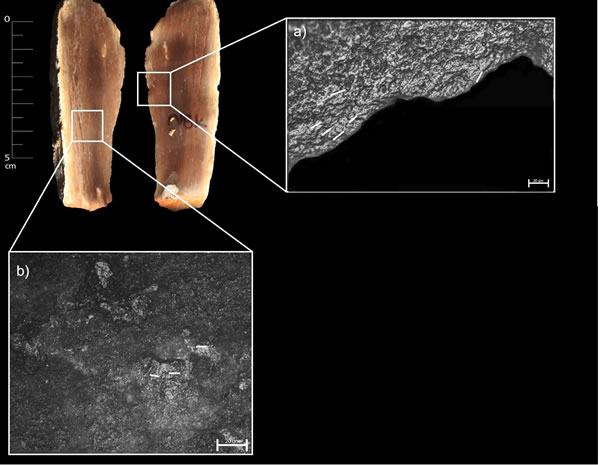
The faunal assemblage includes Dama mesopotamica (dominates the assemblage), Bos, Equus, Sus, Testudo, Cervus. The absence of all body parts indicates that carcasses were first processed outside of the site and only selected parts were brought to the cave. Furthermore, cut marks were abundant indicating butchering on-site. Use-wear and residues analyses reviled that at Qesem Cave hominins used blades, Quina and demi-Quina scrapers and small items from recycling to process animal and plant materials. There is no doubt that these categories of tools were used as specialized tools-kit during butchering. In particular, Quina scrapers were used as specialized toolkit to process fresh, semi-dry and dried hide. New extraordinary data, published in 2019 and 2020, documented: 1 – the use of recycled old spheroids macro-lithic tools for the breakage of bones, probably to exploit their marrow, 2 – a complex behaviour of manipulation of animal and plant (tubers) food consisting in roasting with hot wooden ash and/or also preserving food and non-food matters using cold ash.
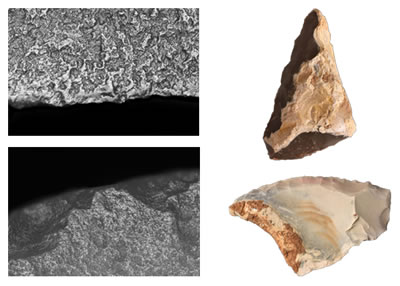
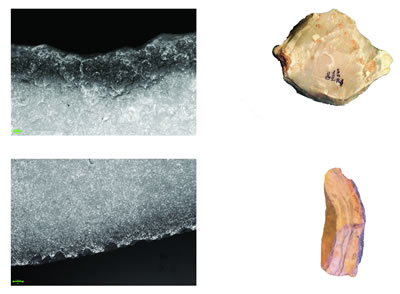
References
C.Lemorini, M.C.Stiner, A.Gopher, R.Shmelmitz, R.Barkai (2006), Use-wear analysis of an Amudian laminar assemblage from the Acheuleo-Yabrudian of Qesem Cave, Israel, Journal of Archaeological Science 33: 921-934. https://doi..org/10.1016/j.jas.2005.10.019
Shahack-Gross R., Berna F., Karkanas P., Lemorini C., Gopher A., Barkai R. (2014), Evidence for the repeated use of a central hearth at Middle Pleistocene (300 ky ago) Qesem Cave, Israel, Journal of Archaeological Science 44, pp. 12-21, doi:10.1016/j.jas.2013.11.015
N., Solodenko; A., Zupancich; S., Nunziante Cesaro; O., Marder; Lemorini, Cristina; R., Barkai 2015. Fat Residue and Use-Wear Found on Acheulian Biface and Scraper Associated with Butchered Elephant Remains at the Site of Revadim, Israel. pp.1-17. PlosOne. doi:10.1371/journal.pone.0118572
Lemorini C., Venditti F., Assaf E., Parush Y., Barkai R., Gopher A. (2015), The function of recycled lithic items at late Lower Paleolithic QesemCave, Israel: An overview of the use-wear data, Quaternary International 361, pp. 103-112, doi:10.1016/j.quaint.2014.07.032
Barkai R., Lemorini C., Vaquero M. (2015), The origins of recycling: a Paleolithic perspective, Quaternary International 361, pp. 1-3, doi:10.1016/j.quaint.2014.12.044
Lemorini C., Bourguignon L., Zupancich1 A., Gopher A., Barkai R. (2016), A scraper’s life history: Morpho-techno-functional and use-wear analysis of Quina and demi-Quina scrapers from Qesem Cave, Israel, Quaternary International 398, pp. 86-93, doi:10.1016/j.quaint.2015.05.013
Zupancich A., Lemorini C., Gopher A., Barkai R. (2016), On Quina and demi-Quina scraper handling: Preliminary results from the late Lower Paleolithic site of Qesem Cave, Israel, Quaternary International 398, pp. 94-102, doi:10.1016/j.quaint.2015.10.101
Zupancich A., Nunziante-Cesaro S., Blasco R., Rosell J., Cristiani E., Venditti F., Lemorini C., Barkai R. Gopher A. 2016 Early evidence of stone tool use in bone working activities at Qesem Cave, Israel, Scientific Reports 6. http//doi:10.1038/srep37686.
Venditti F., Cristiani E., Nunziante-Cesaro3 S. Agam A., Lemorini C., Barkai R. 2019 Animal residues found on tiny Lower paleolithic tools reveal their use in butchery, Scientific Reports. https://doi.org/10.1038/s41598-019-49650-8
Assaf E, Caricola I, Gopher A, Rosell J, Blasco R, Bar O, Zilberman, E., Lemorini, C., et al. (2020) Shaped stone balls were used for bone marrow extraction at Lower Paleolithic Qesem Cave, Israel. PLoS ONE 15(4): e0230972. https://doi.org/10.1371/journal.pone.0230972
Lemorini C., Cristiani E., Nunziante Cesaro S., Venditti F., Zupancich A., Gopher A. The use of ash at Late Lower Paleolithic Qesem Cave, Israel—An integrated study of use-wear and residue analysis, PlosOne (2020). https://doi.org/10.1371/journal.pone.0237502
Mathias, C.; Lemorini, C.; Marinelli, F.; Sanchez-Dehesa Galan, S.; Shemer, M.; Barkai, R.. (2023 Bulb retouchers half a million years ago: New evidence from late Acheulean Jaljulia, Israel, JOURNAL OF ARCHAEOLOGICAL SCIENCE: REPORTS. – ISSN 2352-409X. – 47:(2023), p. 103821. [10.1016/j.jasrep.2022.103821]

